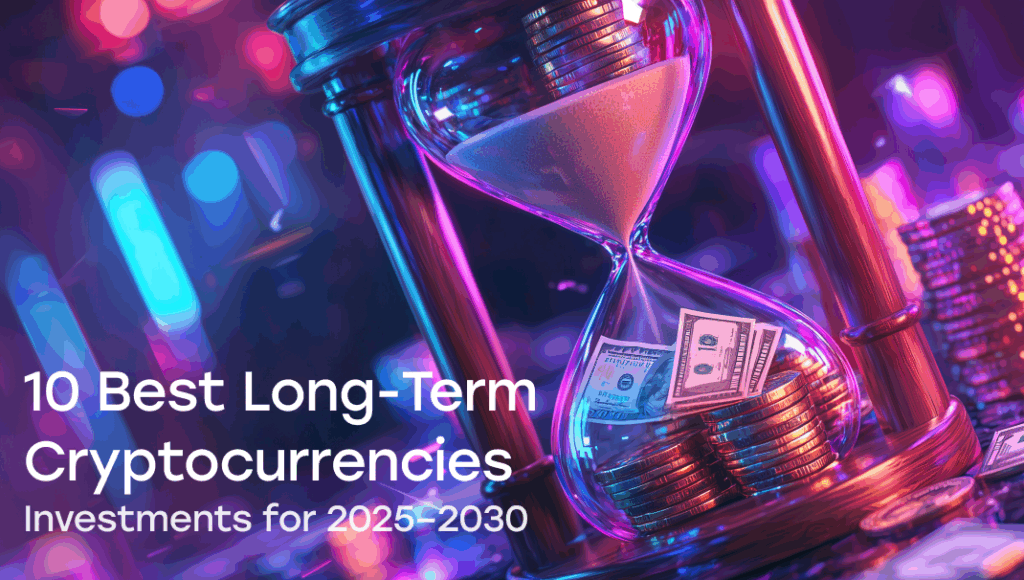share
The blockchain has been making colossal strides ever since it entered the market. So far, it has revolutionized the way we think of finance, and right now, it’s full steam ahead towards revolutionizing the way we use it. Apart from the innovations introduced in currency, trading, and consumer economics, it has also brought about a groundbreaking new form of entertainment: play-to-earn games, aka NFT games.
After a couple of decades of evolving into something ‘adults’ can finally enjoy, video games have discovered, tested, and employed a variety of business models and ways to monetize the players’ time and in-game content.
The one model we’re going to focus on today is called Play-to-Earn, and it’s exactly what the name implies: playing the game to earn money. Certain elements of this model had been scattered across the gaming industry in the past, but it was a blockchain that eventually put them together in a coherent picture.
But first, let’s take a look at the other two prevalent models.
The Most Dominant Business Models in Gaming
Pay-To-Play Games (P2P)
From its onset back in the 1970s all the way into the 2000s, the gaming industry was based almost entirely upon the Pay-to-Play (P2P) model.

This model employs a standard market sales mechanism: the player pays once to play the game and receives a copy of the game upon purchase (or access to the game within a pre-paid subscription term).
After that, they’re free to play their copy of the game without restrictions; all further monetization here comes in the form of add-ons or DLC (Downloadable Content) – additional free or paid unlockable content released further down the line after the game’s launch.
Free-To-Play Games (F2P)
Free-to-play is the “golden apple” of traditional video games. The player doesn’t pay any entry cost but rather downloads and plays the game free of charge and then decides whether or not they’d like to put in a few bucks.
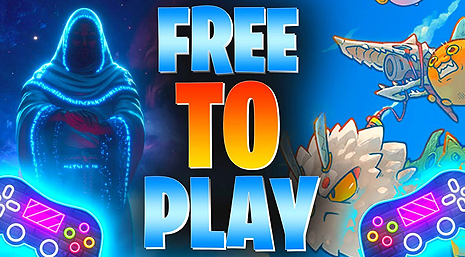
The idea sounded counterintuitive to just about everyone when it first came about, but then it quickly gained popularity and has since proven to be one of the best monetization models imaginable if executed right. In this model, the player buys in-game content already after investing some time into the free-to-play game and having decided if they like the game enough to start paying for it.
In PC and console gaming, this business model usually implies unlocking in-game assets that somehow boost the player’s experience with the free-to-play game or just make their character to equipment look cooler. The viability of this model depends entirely on the type and the quality of the base game and its paid content.
In mobile gaming, F2P is usually backed by ads. Independent, smaller-scale devs and studios roll out their games where the player most often doesn’t have to pay a single penny for playing the game. However, they have to watch ads, be it pop-ups or on-screen banners. A cunning mobile game maker will also include the ‘watch-to-play’ variety into their game, where the player can choose to consciously watch ads in exchange for in-game items, boosters, etc.
The Downsides of the ‘Traditional’ Business Models
The problem with the business models described above is that there is a unilateral decision-making process spanning all facets of the game’s core mechanics and economy, and the player is always on the receiving end. There is little to no player agency over the game files, in-game assets and progress. Players can also be stuck with subpar or outright broken content they couldn’t have possibly tested before paying for it, ultimately resulting in their money being wasted. What’s more, the player may have put in 1000+ hours and as many dollars into the game but should the server go down, all that will be lost.
Play-To-Earn Games(P2E)
Play-to-earn gaming leverages the power of on-chain assets and blockchain transparency to offer an all-new approach to asset management, community and user engagement, and monetization schemes.
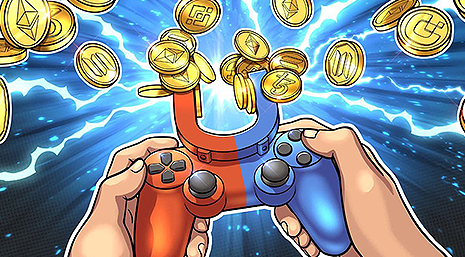
In short, Play-to-earn games pay the player for playing them.
This model represents multilateral monetary incentives, allowing players to extract monetary value out of their gaming hours and motivating them to take extra steps beyond just playing the play-to-earn game to strengthen the game’s community and economy – in exchange for further monetary rewards.
There are two ways players can earn crypto in play to earn games: through gameplay and by earning & trading NFTs.
The former implies that players get rewards in the game’s native token as they go about playing the play-to-earn game. The exact actions that are rewarded are up to the developers but normally include winning, completing simple tasks (like logging into the play-to-earn game once per day, playing 5 rounds in a day, winning 4 battles in a week, etc.) and other actions, including being active in the game’s social media.
The Economic Pillars of Crypto Games
Play-to-earn games pose as the alternative to ‘traditional’ games not only in the way they monetize the in-game economy but also in the way they sustain themselves in doing so. The key difference here is that, unlike mainstream gaming, play-to-earn games also empower the players. Here’s how they do it.
The Game’s Native Token
The cornerstone and the overall driver of a GameFi experience is the game’s native token. The players can earn rewards in the token by simply playing the play-to-earn game, winning, and completing tasks. They can claim the rewards right away, have them credited to their crypto wallets, and trade them on crypto exchanges like they would any other crypto coins.
Thus, the game’s core mechanics are intertwined with the minting and distribution of the in-game tokens, and the success and economic growth of a play-to-earn game largely depend on it too. The better the game is and the more fun it is to play, the higher the demand for its in-game currency and, therefore, the higher its price.
NFT In-Game Items
The second pillar of play to earn games is the NFT in-game items. Every single playable asset: a character, a weapon, a cosmetic item or just a collectable – all come as NFTs. This results in an unprecedented level of player agency over their in-game assets that had never been seen in mainstream gaming. The assets can be bought on the in-game store, and external NFT marketplaces won and/or looted during gameplay or transferred between users like any other NFT. Whereas in mainstream gaming, game assets belong to the publisher/developer, in blockchain games, they belong to the player.
NFT game assets can be instantly viewed and managed across multiple wallets and network protocols. You can send them to anyone at any time, sell them, or even burn (=destroy) them should you wish to do so. Thus, instead of being a mere buyer, the player is put in the decision-making seat.
Community Treasury
It’s worth noting that blockchain game developers don’t pay the rewards out of their own pockets. For that, there are community treasuries — dedicated pools of the game’s native tokens and other assets. The players get their rewards from the treasury, and the devs also share in its revenue.
Secondary Market
The flexibility offered by NFT in-game items opens up a whole new perspective on secondary markets. In traditional gaming, there are also markets where players buy and sell in-game items from certain play to earn games – weapons, cosmetics, and other collectables – but the problem here is that these markets are usually game-specific and are economically isolated from one another. Blockchain can put that right by providing opportunities for seamless trading of any in-game assets across the board.
Royalties
What’s more, NFTs can have a royalties algorithm built into them, so with each subsequent resale, the creator automatically receives a portion of the revenue from it. Thus, a whole new type of incentive is discovered, which could not have been done before. The players are actively encouraged to trade their in-game goods second-hand and thus play an active part in bringing profit to its creators.
What’s even more, thanks to the blockchain data being transparent and open to all, the devs can study these over-the-counter sales and gather valuable insights that they can use to track trends and further boost their monetization schemes.
DAOs and Governance Tokens
A huge part of the DeFi ecosystem revolves around Decentralized Autonomous Organizations, or DAOs for short. DAOs are essentially community-driven management boards, where users can socialize and vote on important decisions pertaining to the project’s development. The voting process is democratic, open to all, and is done through the platform’s governance token – a crypto token designed specifically to fuel the DAO’s ecosystem. Play-to-earn games leverage the power of DAO governance by operating two tokens at once. The governance token, as well as the main in-game token, can be earned through gameplay.
Axie Infinity’s AXS Governance Token Model
For example, Axie Infinity rewards its players with a token called Smooth Love Potion (SLP), which is also a utility token used to fuel the crossing of Axie pets. Apart from SLP, there’s also AXS, Axie Infinity Shards, used for governance in the Axie Infinity DAO. The most ingenious part is that a small amount of AXS is also paid for each crossing of Axies as a commission for the blockchain transaction. Thus, this play-to-earn game encourages the player to buy, hold, and constantly use both SLP and AXS tokens, in turn boosting the market demand for both.
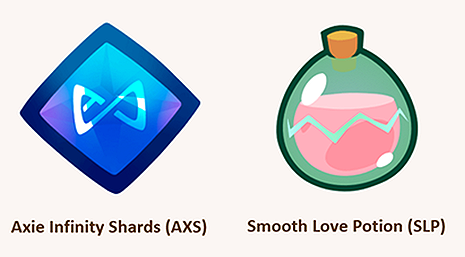
One game that takes this formula one step further is Alien Worlds – a gamified crypto mining experience. Alien Worlds is set in a solar system with 6 playable planets, each being its own fully-fledged DAO.
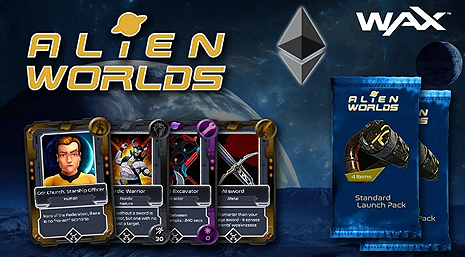
All the planets report to the Federation, which is basically the development team. The Federation provides planets with monetary support and other benefits, which can ensure a diverse player experience across the system.
Governance Staking
Apart from holding, trading, and using in-game and governance tokens, players can also stake them, securing themselves passive income as well as extra voting rights. The staked coins are used by the platform to ensure higher liquidity and a larger market cap of the game’s ecosystem.
Play to Earn Game Guilds
The concept of gamers uniting in closed communities – clans or guilds – is, of course, nothing new. Guilds have been central to every massive multiplayer role-playing game like World of Warcraft or League of Legends, and they serve the purpose of enriching the players’ experience and providing some exclusive content and ways to play the game not available elsewhere. Gamers join clans to build strong, long-lasting social bonds based on shared values, objectives, and playstyles. With the power of blockchain, GameFi guilds take this concept to a whole new level.
In play-to-earn games, guilds take the form of DAOs. A guild is a fully-fledged ecosystem curating a certain portion of the game’s community. Guilds can provide players with unique content that they first get access to, as well as valuable insights into the game’s earn mechanics.
Rent-To-Play
It’s worth noting that play-to-earn games, depending on their popularity, can have a pretty steep entry threshold. While some play-to-earn games are completely free and generous for newcomer rewards, others will ask several hundred, if not a thousand, dollars of you as an initial investment. This was seen as a problem until recent years, when the concept of rent-to-play was introduced.
The idea is that certain play-to-earn games allow players or guilds to rent out their in-game NFTs to other players and earn interest on the profits of their borrowers. Thus, they’re giving a helping hand not only to the players wanting to enter the game without having to pay through the nose but also to the developers of the game, drawing larger audiences to the game at no additional cost.
The Best Play-To-Earn Crypto Games
Now let’s have a look at some of the most prominent examples of play-to-earn games and talk about their core mechanics and business models.
Axie Infinity
Launched in 2019, Axie Infinity is today’s gold standard of play-to-earn crypto games.
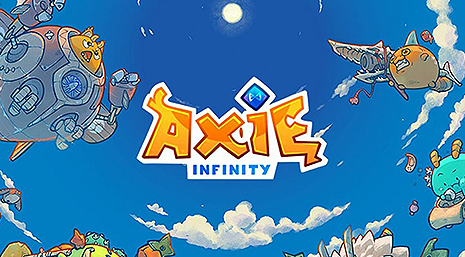
It’s a play-to-earn game whose gameplay revolves around breeding and battling exotic pets called Axies. The core mechanics are fairly simple: the player needs to assemble a party of 3 Axies and battle them against that another player. The winner gets rewarded with Smooth Love Potion (SLP) tokens that they can either use to breed new Axies or sell on crypto exchanges.
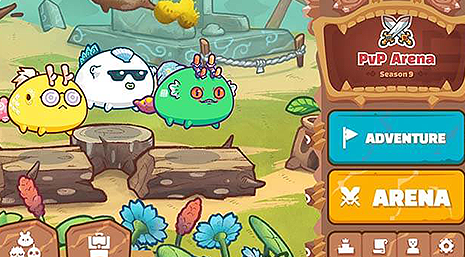
The cornerstone of Axie Infinity’s in-game economy is breeding. Two pets can be crossed, resulting in unique new Axies (although you can’t cross parents and children or siblings).
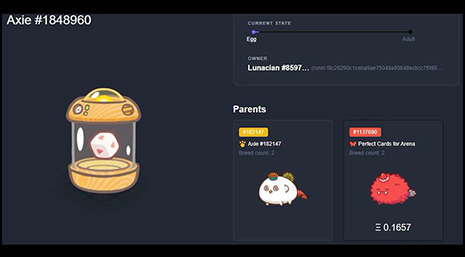
Each ‘child’ inherits the genes of its’ parents’ in three categories: dominant (D), recessive (R1) and small recessive (R2) gene. The genes are entirely RNG-based, so the player can’t design their own Axie: each pet is unique.
Each Axie can be crossed a maximum of 7 times, and each crossing costs more SLP than the previous one. When crossing Axies, the SLP spent by the player is burned on the blockchain, nipping its inflation in the bud. There’s also a flat fee of 0.5 AXS per crossing, which makes the in-game economy driven by two crypto tokens at once, ensuring constant and steady market demand for both. With each new player willing to play the game, there’s guaranteed demand for both tokens.
Each Axie is an NFT, and to start playing the game; you need to buy at least 3 Axies. With the floor price hovering around $20-30, some of the more prospective pets can easily cost tens of thousands of dollars. This would prevent new players from entering the play to earn the game and getting the taste of the more advanced parts of its gameplay, but the so-called Scholarships have got these players covered. Scholarships are a program wherein more experienced players can become “managers” and rent their Axies out to newcomers for a cut of their SLP earnings. Thus, they make the game significantly more accessible to newcomers, also earning passive income along the way.
The recent metaverse craze couldn’t pass Axie by, and Axie Infinity does have a metaverse of its own to offer. It’s called Lunacia, and its pillars are NFT land plots.
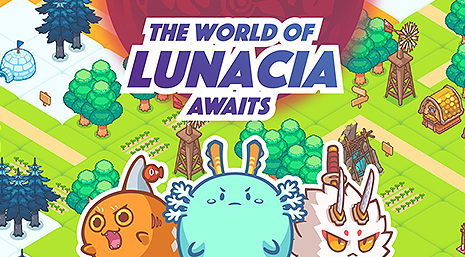
In Lunacia, players can engage in an open-world adventure where they explore and loot their own land plots and can visit and explore those of other players. The world of Lunacia is populated by powerful NPC monsters called Chimeras, which players have to face off against in exchange for higher SLP rewards and better loot. The floor price of a Lunacian land plot is about 1-2 ETH, with the most expensive ones trading for hundreds of thousands of dollars.
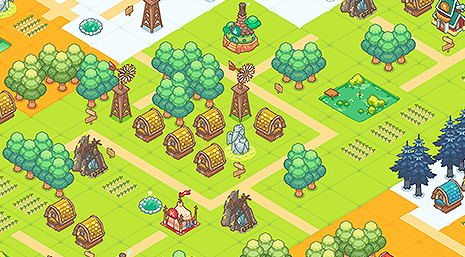
Thanks to its exemplarily sustainable ecosystem, Axie Infinity is so hot these days it’s becoming a magnet for all the “right” things a play-to-earn game should have. Apart from the tokenomics and the trend-savvy Lunacian world described above, Axie Infinity also runs as a DAO where users can stake their AXS coins for extra rewards and host a growing number of guilds. These guilds, working in close cooperation with the game community, are offering unique content and ways to play the game, i.e. earn money.
Sorare
Sorare is a fantasy football NFT card play-to-earn game where players trade, collect and win player cards in fantasy tournaments. Valued at around 3 billion dollars, Sorare is also supported by a number of football legends – Antoine Griezmann, Rio Ferdinand Cesar, and Gerard Pique, to name a few.
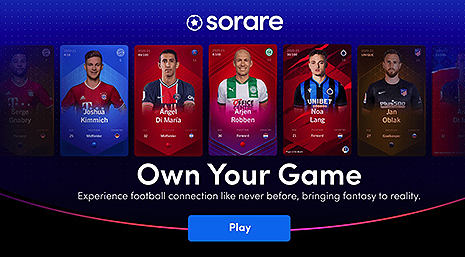
The game draws heavily from the once-ubiquitous Panini football stickers, except it has a limit on how many cards or each rarity tier can be issued to one player: 1000 Limited, 100 Rare, 10 Super rare, and 1 Unique. Rarity also directly affects the chances of the card winning in a fantasy football tournament. Naturally, all cards come as NFTs that can be traded for crypto.
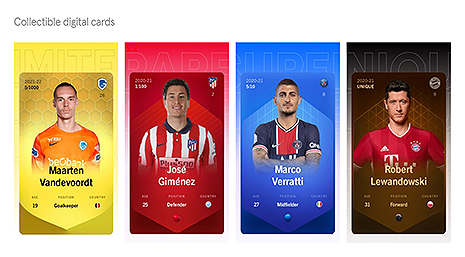
Upon signing up to Sorare, the player joins a club and gets a dozen Common cards as an entry bonus. The gameplay revolves around assembling your own fantasy team or real-world footballers, joining leagues with the team, and playing fantasy matches to earn rewards. The leagues differ in possible rewards and the level of challenge, but they are in turn split up into divisions that also have different reward tiers.
Tournaments are held weekly, and winners from tougher leagues can get tier-1 rewards which can turn out to be footballer cards that cost hundreds of thousands of dollars. What’s interesting about Sorare is that the performance of in-game NFT cards is directly impacted by the real-world performance of their IRL counterparts. Thus, Sorare acts as a bridge between the blockchain and the real world, with actual football legends buying into the game, thus gaining further incentives to win more.
TownStar
Created by the darling of blockchain gaming, Gala Games, TownStar is a city builder-farmer type of game where you build your own city from scratch using different kinds of NFT resources.
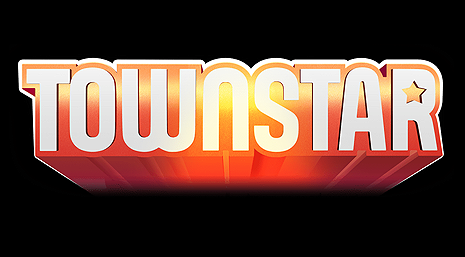
It’s worth noting that Gala Games was founded by the co-founder of Zynga, who created the famous FarmVille. TownStar is a direct descendant of FarmVille, except it brings a bunch of blockchain-exclusive features to the table. First, all resources, parts, and tools available in-game can not only be used for building but can also be traded since they’re all NFTs. This creates a flexible and sustainable ecosystem allowing players to farm and collect rarer materials, which they could then convert into large gains.
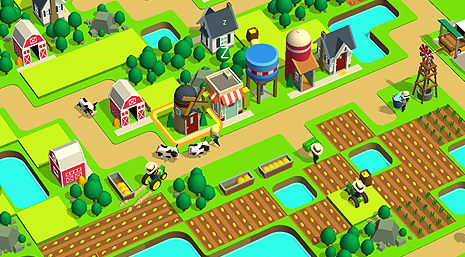
One way TownStar and Gala Games stand out is their bespoke play to earn mechanics based on the in-game currency TOWN. In it, players can earn extra rewards in TOWN tokens depending on the scarcity of the NFT in-game items that they’re using. The rarer, the more rewards. However, it’s not passive income, and players have to play the game, complete daily challenges and place their NFT items on farms to earn those rewards.
There is a limit to how many NFTs can be placed on farms, and that limit is defined by a metric called Gala Power. Each player’s Gala Power is influenced by a number of factors, including account age, the number of GALA and TOWN in their wallet, referral history, etc. As you can imagine, these metrics are never set in stone and are constantly shifting depending on player engagement. In the end, players showing the most commitment to the game’s (and the studio’s) ecosystem reap the biggest rewards.
TownStar also has regular tournaments where players can flaunt their towns, compete with other players, and earn crypto game rewards in both TOWN and GALA tokens. The GALA tokens can be either sold, used to boost the player’s Gala Power, or staked on the Gala network for passive income and voting right. What’s more, GALA has utility outside TownStar: as Gala Games releases new play to earn projects, they’ll all have GALA coins used in the same way they are in TownStar.
Final Thoughts on Crypto Games
Blockchain games are definitely the hottest trend of the past couple of years. Partly thanks to the 2020 COVID pandemic, more and more people are viewing play-to-earn as a viable source of both income and fun. The entry threshold varies among all play to earn crypto games, and while some blockchain games require nothing to get started, others need hundreds, if not thousands of dollars of the initial investment.
This will be viewed as a con by many traditional gamers, and seemingly for a good reason: it certainly doesn’t sound ‘normal’ to pay $200 bucks just to start playing a game – that’s not how most people imagine the “earn” part. However, unlike in mainstream gaming, crypto games do not seek to cash in on the player.
How to Enter the Play to Earn Market
If you feel like the idea of joining the play to earn realm tickles your interest, you’ll need professional help. To start your journey in the most efficient way possible, consider using the services of the ICODA blockchain agency. ICODA is a multinational team of seasoned experts in blockchain and crypto development with years of proven experience in the field. We will help you lay down the business model for your crypto game and provide the full range of development services, including post-launch support. With ICODA, you’re guaranteed to gain a solid foothold in the growing play to earn market.




